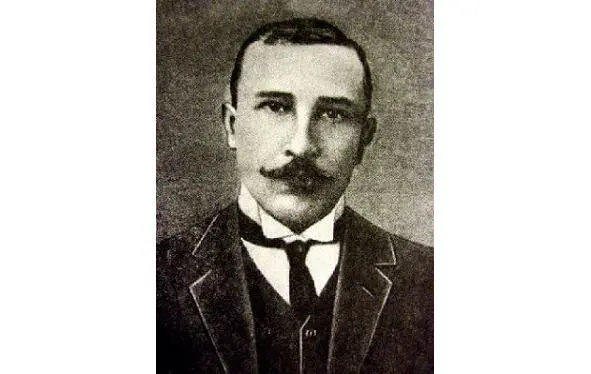
9
1. A popular banknote of that time, 25 rubles (a room in a working hostel, for six months.) A simple horse is also 25 rubles. One ruble is pancakes with fresh caviar in a tavern to a dump, the price of 1911.
2. 50 paper kopecks in 1915, five loaves of bread already risen in price.
3. One of the first tanks in the world (armored combat vehicles) – “Netopyr”, a reflection of the technical thought of the time. The idea of caterpillars has not yet been mastered, the decrease in specific pressure on the ground is achieved by unnatural increase in the diameter of the wheels. Combat weight – 60 tons. Armament: two 76.2 mm. guns, 60 shots, eight 7.92 mm. machine guns “Maxim”. Booking: board, forehead 10 mm. Crew – 15 people. The height of the building is 9 meters (fourth floor). Estimated speed along the highway is 17 km. h, a reserve of 60 km. Specific power 8.5 hp In 1915 one specimen was built, due to incorrect centering of the mass, it immediately stalled, it was not accepted for service. If this is a response to the advance of German troops, then the answer is incorrect. According to the “conspiracy theory” the project was sponsored by officials acting in the interests of Great Britain. They also stopped the project of Perekhovshchikov’s “Outlander”, not quite considered, but promising, capable of becoming a wedge.
4. Caterpillar armored car “Austin-Kegress”, he, according to the opinions of quite competent contemporaries and “light Russian tank.” Weight 5.8 tons, crew 5 people, vertical booking 8 mm., Roof 6 mm. Armament: two 7.62 mm. machine gun “Maxim”. Specific power: 9 hp The speed on the highway is 25 km. h, the power reserve is 100 km. Ground pressure 0.3 kg. per sq. m. cm.
On tests the armored car shows itself from the best side. However, the production of military vehicles, which began in 1917, is frozen until 1919. Using the already available parts (in particular, about 200 ready-made propellers – the so-called “tapes”), workers at the Putilov plant collect 12 semi-track armored cars. Further, “Austin-Kegressy” with success (as far as it is possible at all under these conditions) is used by the Red Army in the battles of the Civil and Polish wars.
The designer of the caterpillar chassis is a French engineer-inventor, and also the manager of the garage of Nicholas II A. Kegress emigrates from Russia to his historical homeland after the October Revolution, works for Citroen, gives rise to a wide range of semi-track armored cars and tractors.
5. Heavy cannon-machine gun armored car “Putilov-Garford”. Weight, depending on the modification of 8.6—11 tons, the crew of 8—9 people, circular booking of 7 mm. (protects from an armor-piercing rifle bullet from 70 meters). Armament: 76.2 mm. gun (fodder) with 44 shots, three 7.62 mm. machine gun “Maxim”. Four-wheel drive. Two steering posts – front and rear. Engine power 30 hp, speed on the highway 18 km. h, the power reserve is 120 km. From 1915 to 1916, 48 cars were produced. Armored cars Putilov-Garford have high manufacturing quality, are actively used in the First World War, the Civil War and, even, according to some reports, at the beginning of the Great Patriotic War.
Photos and characteristics of these types of military equipment in Russia are listed here separately to determine the overall situation with the military construction of the pre-revolutionary Empire. At the present time, the thesis that, without the October Revolution, the annihilation of millions of peasants, subsequently the intelligentsia and higher officers, the Soviet Union (the “Red Empire”) would not have created a developed heavy industry, and a well-armed Army. This is not quite true. Pre-revolutionary Russia is a medium-developed capitalist state. This provision is clearly marked even in Soviet history textbooks, which tend to tarnish our entire pre-revolutionary period. A defense order, bad or good, takes precedence over all other aspects of the life of the Russian state. Under the tsar, defense plants produce high-quality armored cars of many types, good artillery systems, small arms, battleships, cruisers, submarines, and, since 1914, for the first time in the world – strategic (and so to speak) Ilya Muromets bombers. Yes, some weapons are bought abroad, but this is quite common in the conditions of a severe military campaign of practice. The Soviet Union also acquires significant amounts of weapons, vehicles and food in the United States and Britain, during World War II. The real reason for some military failures – the tsarist army, or the Soviet army, at the beginning of the Great Patriotic War – the lack of consolidation of society, the creation of a false picture of reality, the desire to shift the individual labor of thinking to a single “higher” personality.
6. One of the people of the era – Alexander Blok, poet of the Silver Age, 1880—1921. The son of a professor at the University of Warsaw and the daughter of the rector of St. Petersburg University. He studied at the Faculty of Law, married the daughter of D. Mendeleev, and maintained contacts with other women. Adopted the revolution of 1917, working on wear and tear in the university, “I forgot how to write poetry.” In February 1919 he was arrested by the Petrograd Cheka on charges of an anti-Soviet conspiracy, released after the intervention of the People’s Commissar of Education, Lunacharsky, outwardly unscathed, but with a mental wound. Already after writing the “Twelve”, at the beginning of “socialist construction,” Blok believed that “the world revolution is turning into a world chest toad.” He died in a Petrograd flat from inflammation of the heart valves.
Pre-revolutionary poems are popular now, they connect mysticism, life and, for example, impressions of the pilots seen on the performance:
…And the beast with the dead screws
Froze a frightening angle…
Look for faded eyes
Supports in the air… empty!
It’s too late. On the grass of the plain
Wing crumpled arc
In the wavers of wires of machinery
The hand is deadlier than the lever
7. Maxim Gorky – Alexei Maksimovich Peshkov, Russian, Soviet writer, 1868—1936. He was born in the Nizhny Novgorod region, the town of Kanavino, in the family of a carpenter. Peshkov’s grandfather, a domestic tyrant, “Eh viii”, colorfully depicted in “Childhood” – an officer demoted for ill-treatment of lower ranks. Traveling around Russia, working as a baker, cooker, etc., Gorky hones his literary talent, five times is nominated for the Nobel Prize, becomes a wealthy man, enjoys success with women. Sponsors the Bolshevik party, on the island of Capri, he establishes the God-building school – in which God is the quintessence of the organized human collective. These ideas are shared by two prominent figures of the RSDLP (b) – A. Bogdanov and A. Lunacharsky, one of the few who did not stain their name with murders.
In the twenties Alexei lives in Berlin, Marienbad (Czech Republic), Sorrento (Italy), returned to the USSR, where he is considered the founder of socialist realism. Again he leaves, appearing in the Soviet Union in 1928 and 1929. Then he visits the ELEPHANT (СЛОН) – Solovetsky special purpose camp, communicates with the prisoners (who read the newspaper “upside down” prominently) and writes a positive opinion about the regime.
Peshkov finally remained in the USSR since 1932. In 1934, after dinner with G. Yagoda, a son dies, Maxim Peshkov (the widow becomes the mistress of the NKVD People’s Commissar), two years later, at the dacha in Gorki, the writer ends his life. Four doctors are accused of poisoning Gorky with chocolate sweets and are being shot. Perhaps the writer was really poisoned by these very sweets, but on instructions from “above”, on the eve of meeting with foreign (uncontrollable) writers, who were about to tell something unnecessary about the existing system. A more likely version is that Gorky gets cold when he visits his son’s grave (pronouncing something like “I was there, where it’s so difficult to come back”) and dies of inflammation, and even stiffness, ie, calcification, lungs.
Читать дальше













